

Compact Muon Solenoid
LHC, CERN
| CMS-PAS-HIG-16-022 | ||
| Search for associated production of Higgs bosons and top quarks in multilepton final states at $ \sqrt{s} = $ 13 TeV | ||
| CMS Collaboration | ||
| August 2016 | ||
| Abstract: We present a search for the associated production of a standard model Higgs boson and a top quark-anti quark pair ($\mathrm{t}\overline{\mathrm{t}}\mathrm{H}$), using LHC pp collision data collected by the CMS experiment at a center of mass energy of $ \sqrt{s} = $ 13 TeV in 2016. The dataset corresponds to an integrated luminosity of 12.9 fb$^{-1}$. The analysis uses events with two leptons of the same charge or at least three charged leptons, produced together with b jets, targeting Higgs boson decay modes to $\mathrm{WW}^{*}$, $\mathrm{ZZ}^{*}$, and $\tau\tau$ and leptonic decays of at least one of the top quarks. The results are combined with the 2015 dataset and yield a $\mathrm{t}\overline{\mathrm{t}}\mathrm{H}$ signal strength of 2.0$^{+0.8} _{-0.7}$ times the standard model prediction. They are used to set a 95% confidence level upper limit on the signal production cross section of 3.4 times the standard model expectation, compared to an expected upper limit of 1.3$^{+0.6} _{-0.4}$ in the absence of a signal. | ||
| Links: CDS record (PDF) ; inSPIRE record ; CADI line (restricted) ; | ||
| Figures & Tables | Summary | Additional Figures | References | CMS Publications |
|---|
| Figures | |
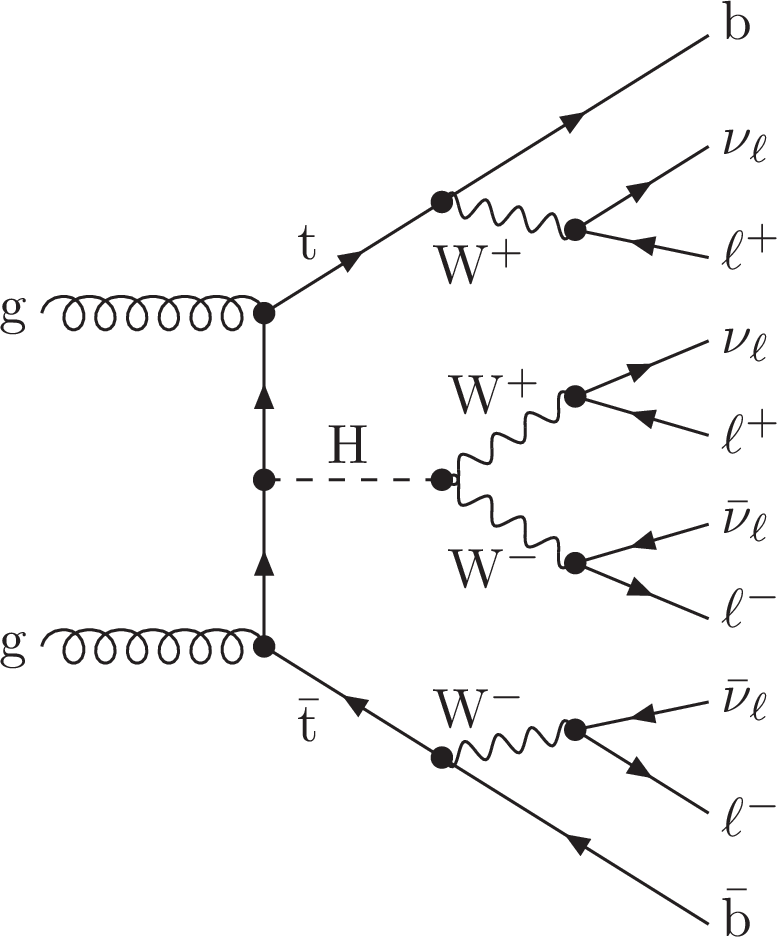
png pdf |
Figure 1-a:
Possible Feynman diagrams for $ { {\mathrm {t}\overline {\mathrm {t}}} {\mathrm {H}} } $ production at pp colliders, where the Higgs boson decays to $ {\mathrm {W}} {\mathrm {W}}^{*}$, $ {\mathrm {Z}} {\mathrm {Z}} ^{*}$, and $ {\tau } {\tau }$ (from a to c). Subsequent WZ, and t decays are shown representing examples of final states with four leptons, three leptons, and two same-sign leptons, respectively. |
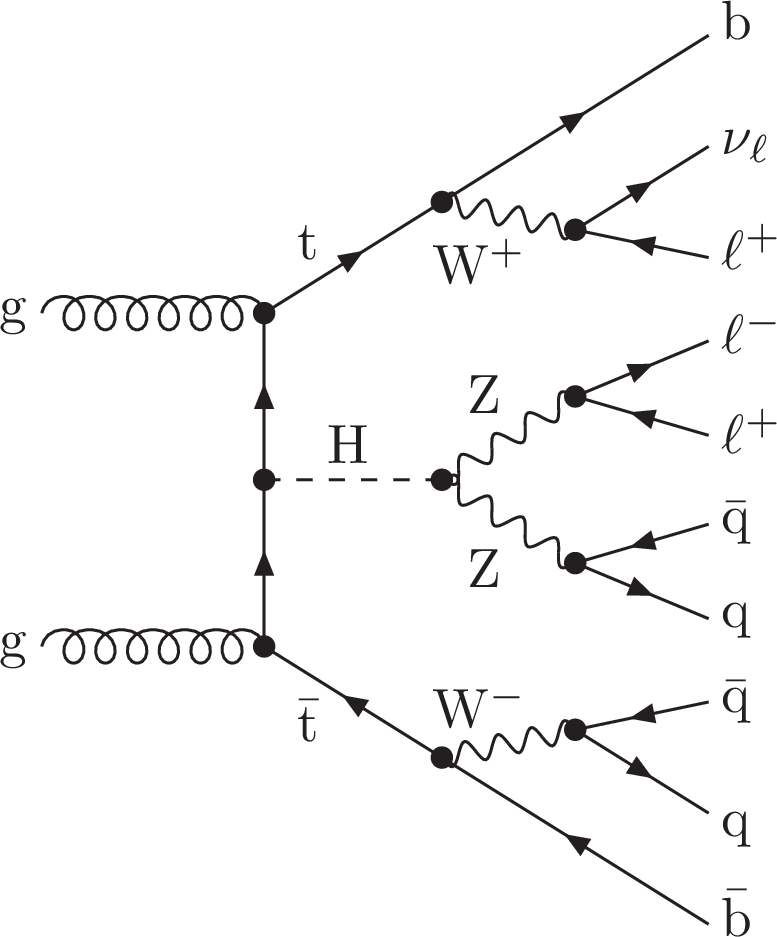
png pdf |
Figure 1-b:
Possible Feynman diagrams for $ { {\mathrm {t}\overline {\mathrm {t}}} {\mathrm {H}} } $ production at pp colliders, where the Higgs boson decays to $ {\mathrm {W}} {\mathrm {W}}^{*}$, $ {\mathrm {Z}} {\mathrm {Z}} ^{*}$, and $ {\tau } {\tau }$ (from a to c). Subsequent WZ, and t decays are shown representing examples of final states with four leptons, three leptons, and two same-sign leptons, respectively. |
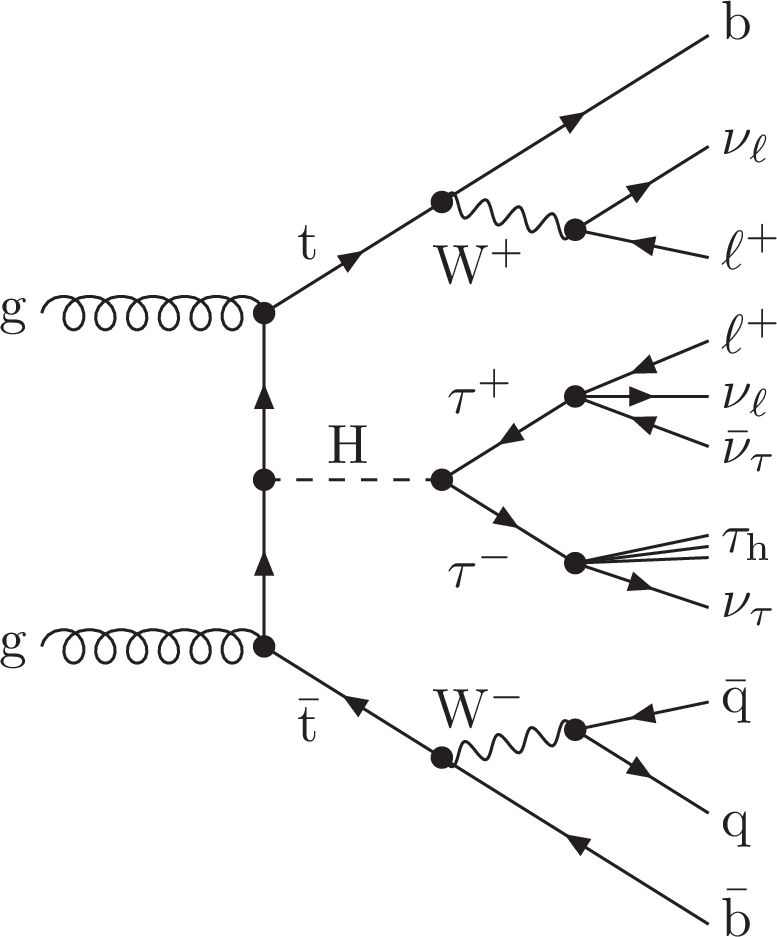
png pdf |
Figure 1-c:
Possible Feynman diagrams for $ { {\mathrm {t}\overline {\mathrm {t}}} {\mathrm {H}} } $ production at pp colliders, where the Higgs boson decays to $ {\mathrm {W}} {\mathrm {W}}^{*}$, $ {\mathrm {Z}} {\mathrm {Z}} ^{*}$, and $ {\tau } {\tau }$ (from a to c). Subsequent WZ, and t decays are shown representing examples of final states with four leptons, three leptons, and two same-sign leptons, respectively. |
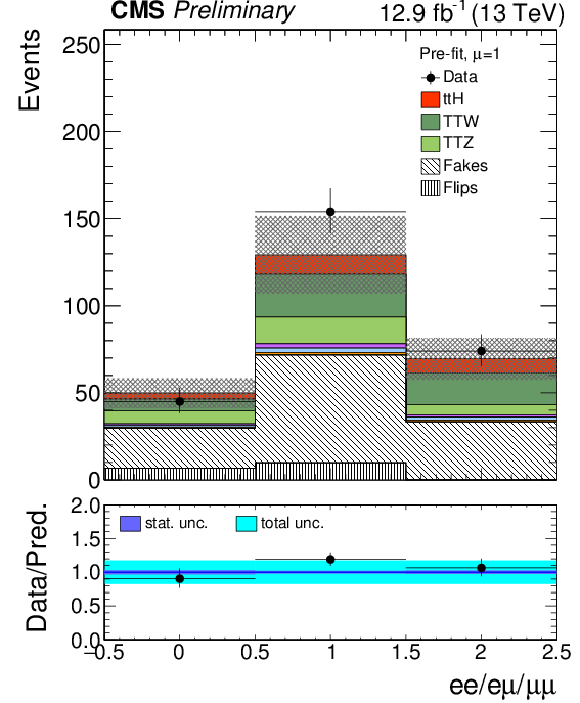
png pdf |
Figure 2-a:
Same-sign dilepton channel; a,b,c: flavor of the selected leptons, number of jets, number of jets passing the medium working point of the CSV tagger; d,e: distributions of the BDT classifier outputs. Distributions are shown before the signal extraction fit. |
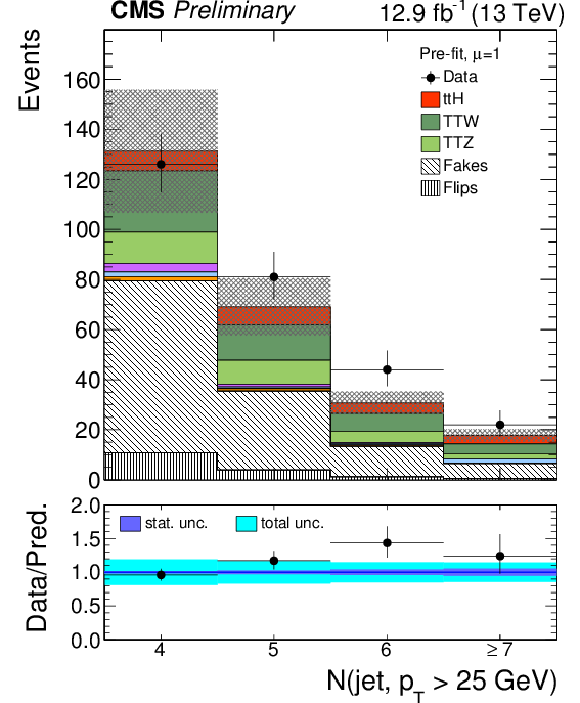
png pdf |
Figure 2-b:
Same-sign dilepton channel; a,b,c: flavor of the selected leptons, number of jets, number of jets passing the medium working point of the CSV tagger; d,e: distributions of the BDT classifier outputs. Distributions are shown before the signal extraction fit. |
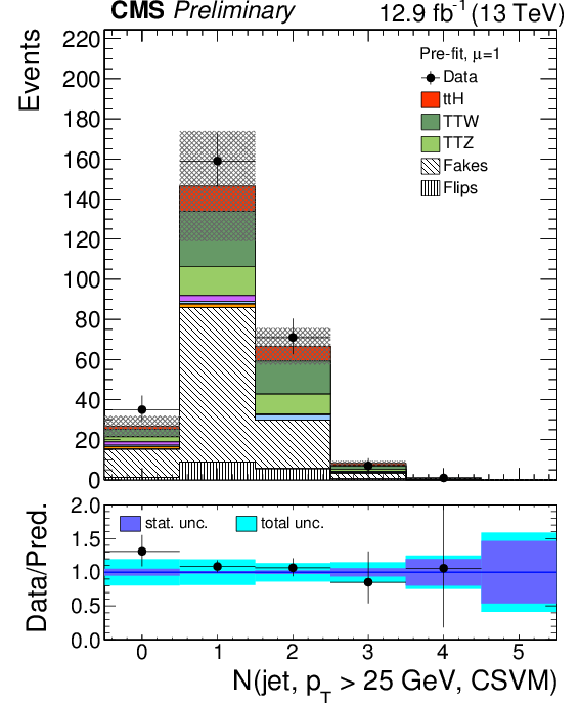
png pdf |
Figure 2-c:
Same-sign dilepton channel; a,b,c: flavor of the selected leptons, number of jets, number of jets passing the medium working point of the CSV tagger; d,e: distributions of the BDT classifier outputs. Distributions are shown before the signal extraction fit. |
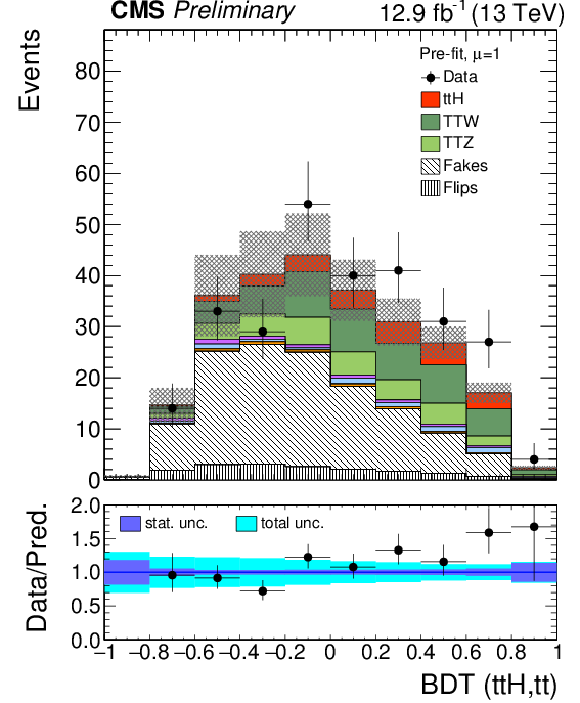
png pdf |
Figure 2-d:
Same-sign dilepton channel; a,b,c: flavor of the selected leptons, number of jets, number of jets passing the medium working point of the CSV tagger; d,e: distributions of the BDT classifier outputs. Distributions are shown before the signal extraction fit. |
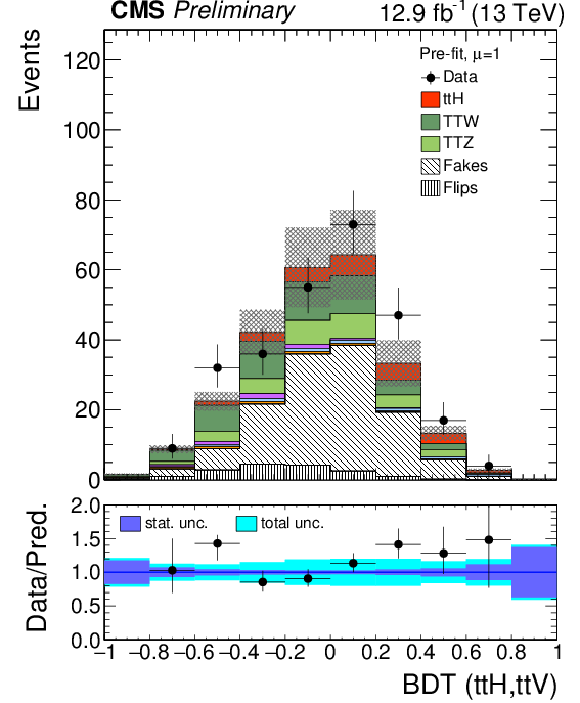
png pdf |
Figure 2-e:
Same-sign dilepton channel; a,b,c: flavor of the selected leptons, number of jets, number of jets passing the medium working point of the CSV tagger; d,e: distributions of the BDT classifier outputs. Distributions are shown before the signal extraction fit. |

png pdf |
Figure 3-a:
Number of selected jets and distributions of the BDT classifier outputs for the three-lepton channel. Distributions are shown before the signal extraction fit. |
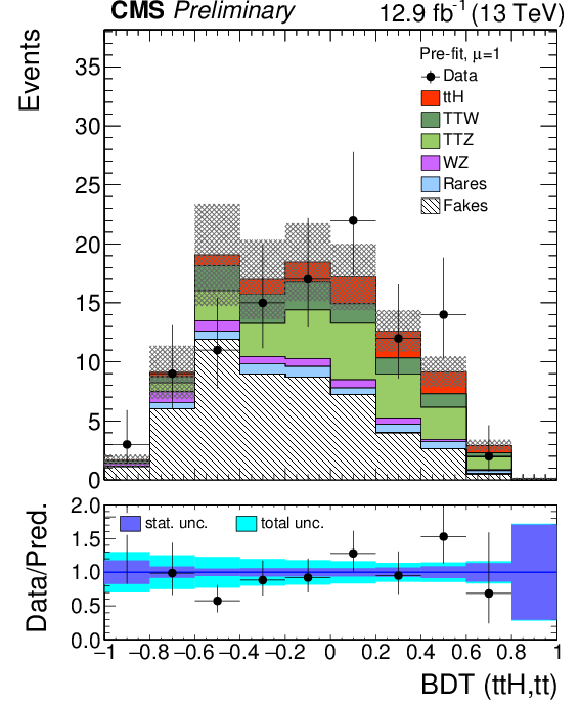
png pdf |
Figure 3-b:
Number of selected jets and distributions of the BDT classifier outputs for the three-lepton channel. Distributions are shown before the signal extraction fit. |
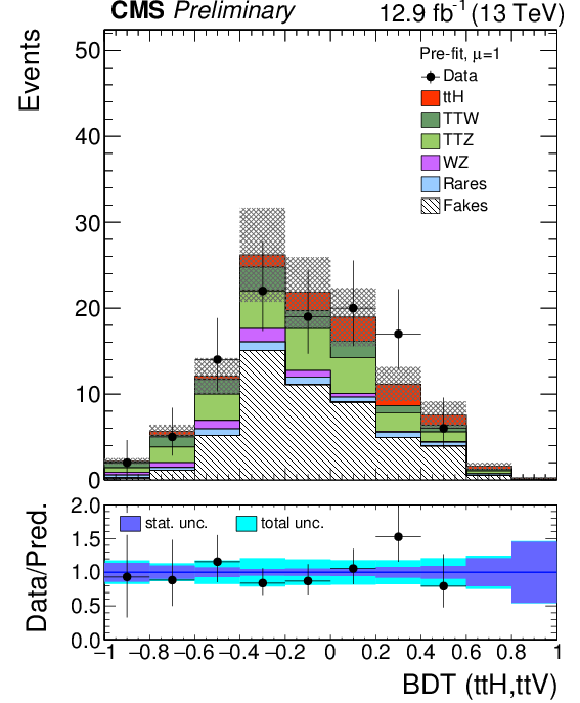
png pdf |
Figure 3-c:
Number of selected jets and distributions of the BDT classifier outputs for the three-lepton channel. Distributions are shown before the signal extraction fit. |
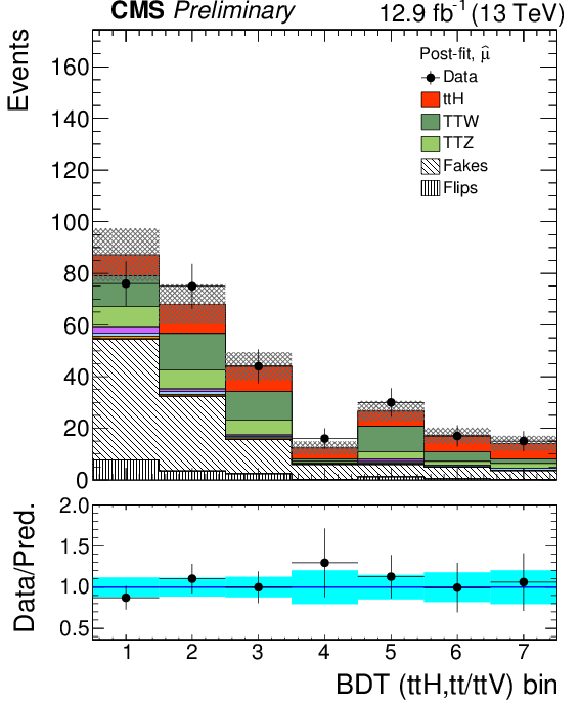
png pdf |
Figure 4-a:
Combination of the BDT classifier outputs in the bins used for signal extraction, for the same-sign dilepton (a) and three-lepton (b) channels. Post-fit distributions and uncertainties are shown. |
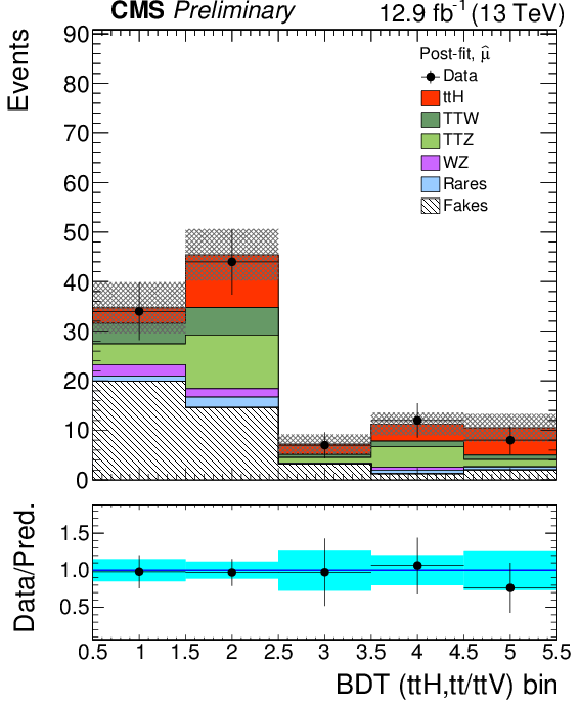
png pdf |
Figure 4-b:
Combination of the BDT classifier outputs in the bins used for signal extraction, for the same-sign dilepton (a) and three-lepton (b) channels. Post-fit distributions and uncertainties are shown. |
| Tables | |
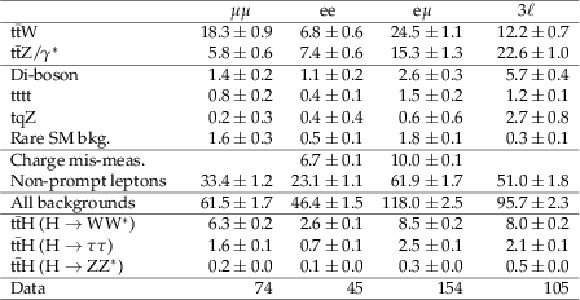
png pdf |
Table 1:
Expected and observed yields after the selection in 2LSS and 3L final states. The rare SM backgrounds include $ {\mathrm {W}}^\pm {\mathrm {W}}^\pm {\mathrm {q}} {\mathrm {q}}'$, $ {\mathrm {W}} {\mathrm {W}}$ produced in double-parton interactions, and triboson production. Uncertainties are purely statistical. The backgrounds from non-prompt leptons and charge mis-measurements are extracted from data. |

png pdf |
Table 2:
Observed and expected asymptotic 95% CL upper limits on and best fit value of the signal strength parameter ($\mu $). |
| Summary |
| A search for the associated production of a standard model Higgs boson and a top quark-anti quark pair has been performed using pp collision data collected by the CMS experiment in 2016 at a center of mass energy of $ \sqrt{s} = $ 13 TeV, and corresponding to an integrated luminosity of 12.9 fb$^{-1}$. The analysis targets Higgs boson decay modes to $\mathrm{WW}^{*}$, $\mathrm{ZZ}^{*}$, and $\tau\tau$ and leptonic decays of at least one of the top quarks. The 2016 dataset is combined with the smaller 2015 dataset at the same center of mass energy. We measure a signal strength of $\sigma/\sigma_{\mathrm{SM}} =$ 2.0$^{+0.8} _{-0.7}$ in the combined dataset, and set a 95% confidence level upper limit of $\sigma < 3.4 \times \sigma_{\mathrm{SM}}$ on the signal cross section, compared to an expected upper limit of 1.3$^{+0.6} _{-0.4}$ in absence of a signal. |
| Additional Figures | |
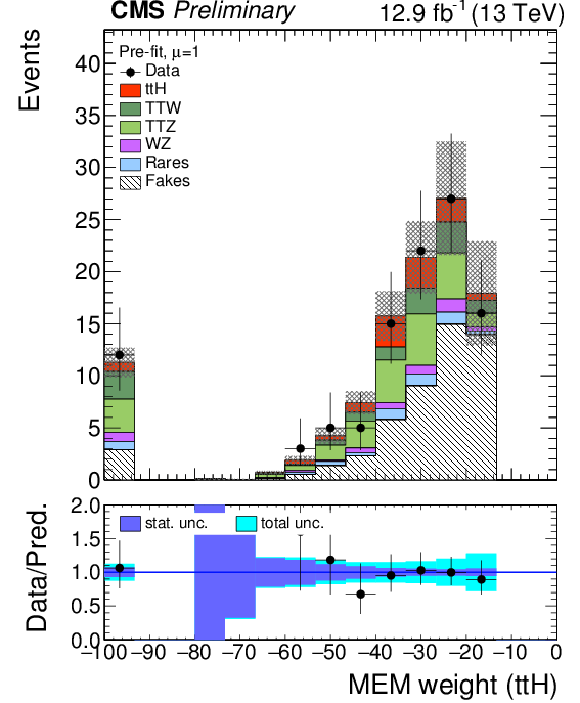
png pdf |
Additional Figure 1-a:
Logarithm of matrix element weights for ${{\mathrm{ t } {}\mathrm{ \bar{t} } } \mathrm{ H } } $, ${{\mathrm{ t } {}\mathrm{ \bar{t} } } \mathrm{ W } } $, and ${{\mathrm{ t } {}\mathrm{ \bar{t} } } {\mathrm{ Z } } }$ after the three-lepton category selection. |

png pdf |
Additional Figure 1-b:
Logarithm of matrix element weights for ${{\mathrm{ t } {}\mathrm{ \bar{t} } } \mathrm{ H } } $, ${{\mathrm{ t } {}\mathrm{ \bar{t} } } \mathrm{ W } } $, and ${{\mathrm{ t } {}\mathrm{ \bar{t} } } {\mathrm{ Z } } }$ after the three-lepton category selection. |
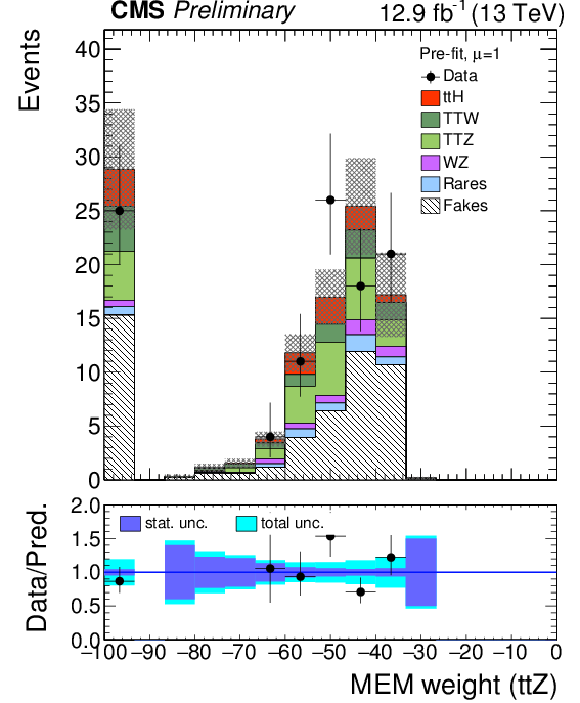
png pdf |
Additional Figure 1-c:
Logarithm of matrix element weights for ${{\mathrm{ t } {}\mathrm{ \bar{t} } } \mathrm{ H } } $, ${{\mathrm{ t } {}\mathrm{ \bar{t} } } \mathrm{ W } } $, and ${{\mathrm{ t } {}\mathrm{ \bar{t} } } {\mathrm{ Z } } }$ after the three-lepton category selection. |

png pdf |
Additional Figure 2:
Impact plot for the five nuisances having the largest effect on the fitted signal strength. |
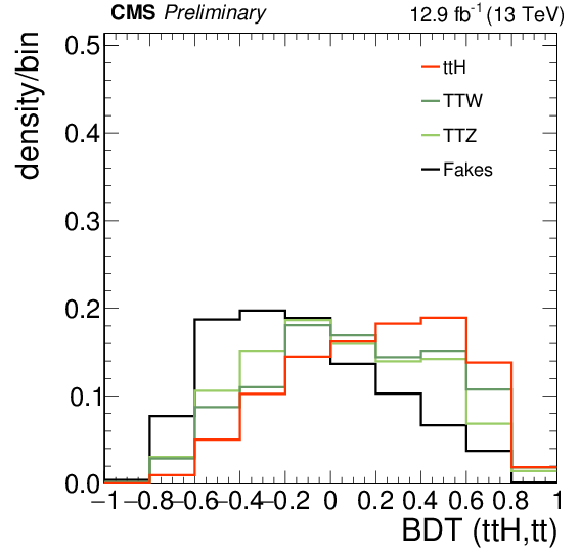
png pdf |
Additional Figure 3-a:
Normalized distributions of the BDT classifier outputs for the same-sign dilepton selection. |
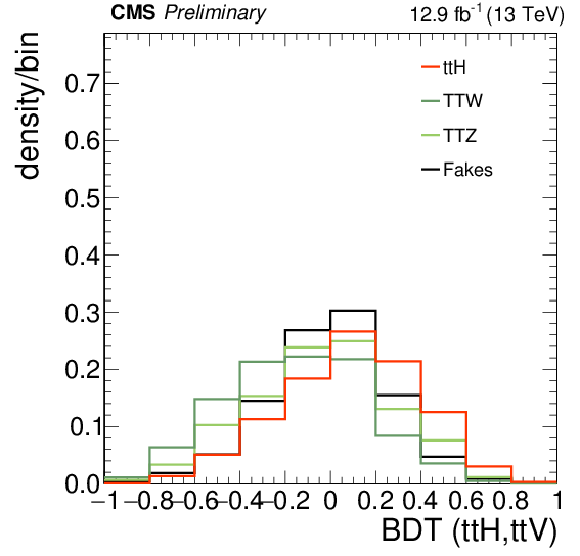
png pdf |
Additional Figure 3-b:
Normalized distributions of the BDT classifier outputs for the same-sign dilepton selection. |
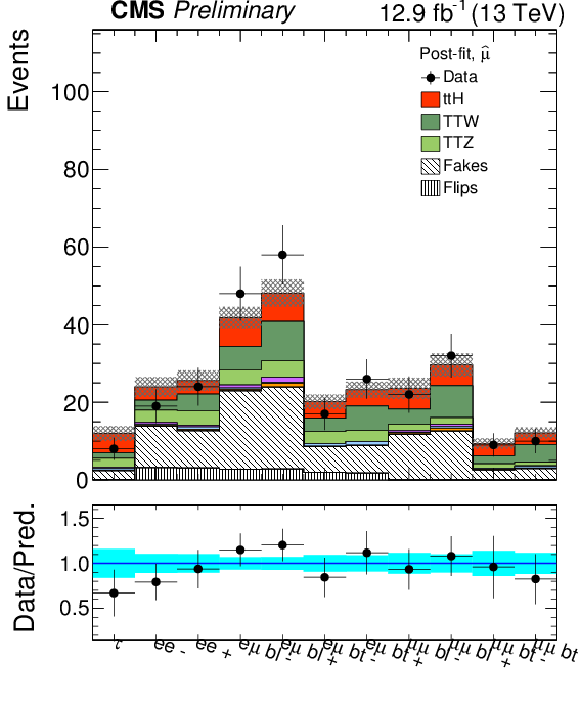
png pdf |
Additional Figure 4-a:
Post-fit yields in each category (a) and in each category-BDT bin (b) for the same-sign dilepton selection. |
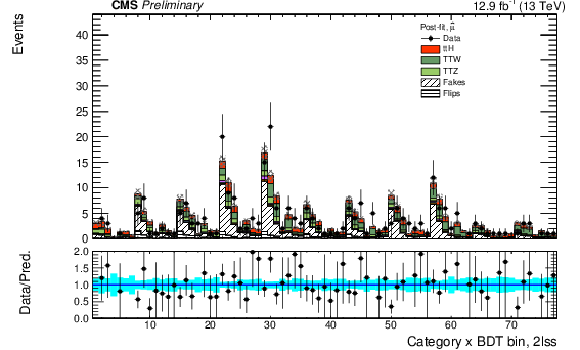
png pdf |
Additional Figure 4-b:
Post-fit yields in each category (a) and in each category-BDT bin (b) for the same-sign dilepton selection. |
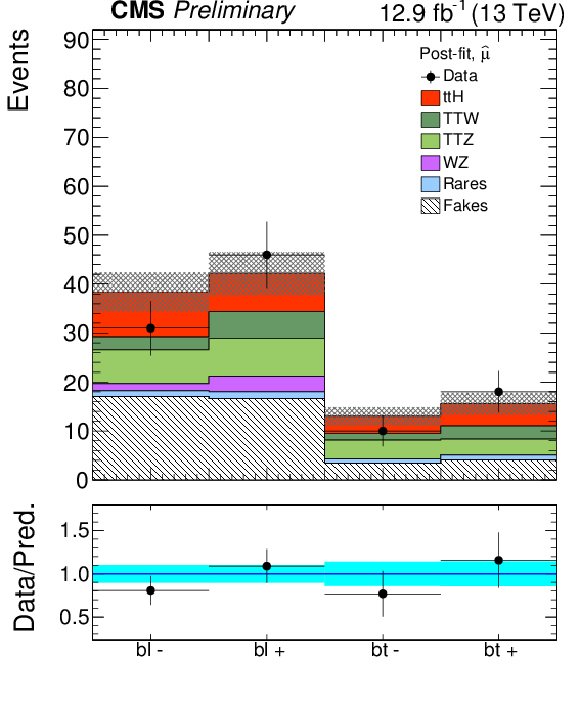
png pdf |
Additional Figure 5-a:
Post-fit yields in each category (a) and in each category-BDT bin (b) for the three-lepton selection. |

png pdf |
Additional Figure 5-b:
Post-fit yields in each category (a) and in each category-BDT bin (b) for the three-lepton selection. |
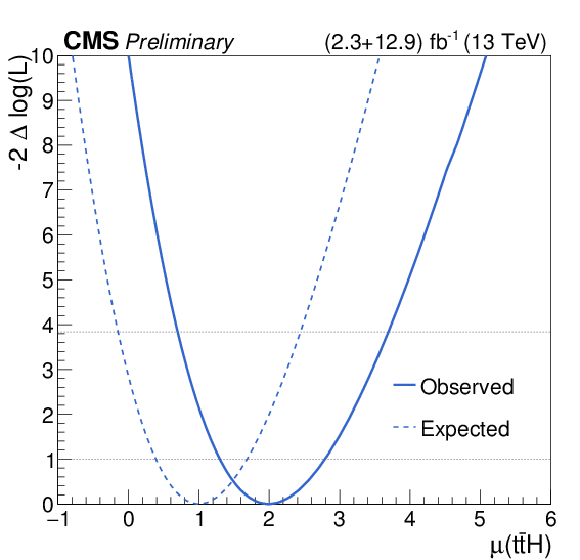
png pdf |
Additional Figure 6:
Negative log-likelihood as a function of the signal strength for the combined 2015+2016 result, as observed in the data and expected from simulation with a standard model signal. Dotted lines at 1.0 and 3.84 correspond to 68% and 95% confidence levels, respectively. |
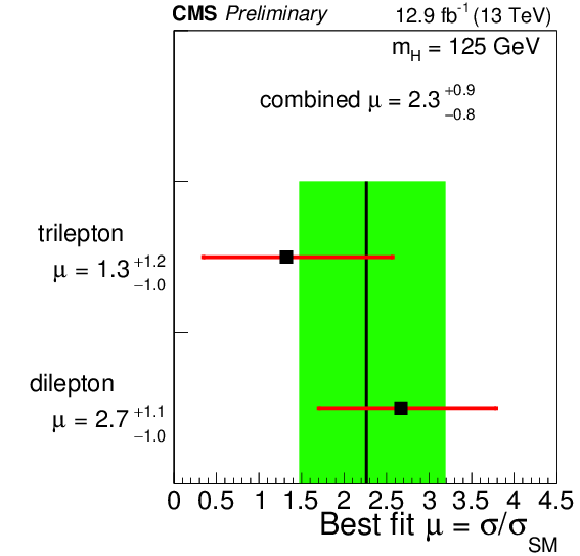
png pdf |
Additional Figure 7-a:
Best fit signal strength for the 2016 analysis alone, in the dilepton and trilepton channels (a), and further split into flavor categories (b). |
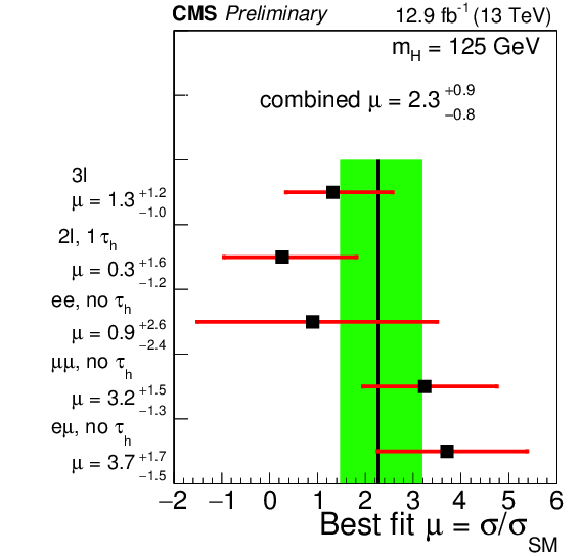
png pdf |
Additional Figure 7-b:
Best fit signal strength for the 2016 analysis alone, in the dilepton and trilepton channels (a), and further split into flavor categories (b). |
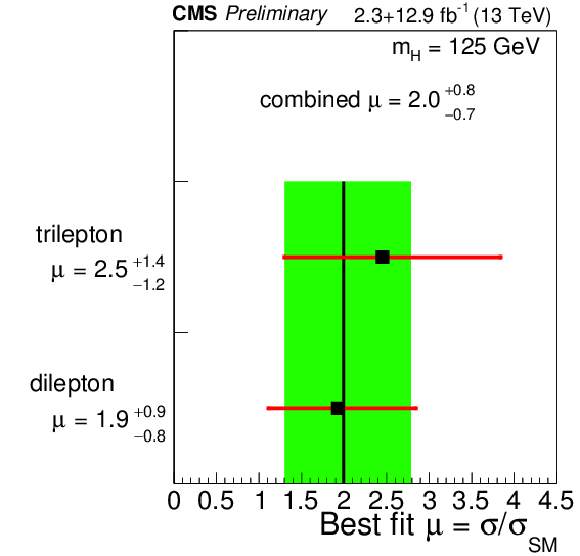
png pdf |
Additional Figure 8-a:
Best fit signal strength for the combined 2015+2016 analysis, in the dilepton and trilepton channels (a), and further split into flavor categories (b). |
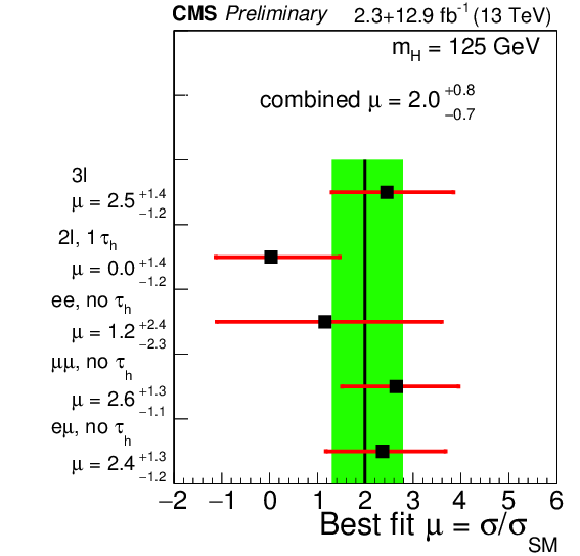
png pdf |
Additional Figure 8-b:
Best fit signal strength for the combined 2015+2016 analysis, in the dilepton and trilepton channels (a), and further split into flavor categories (b). |
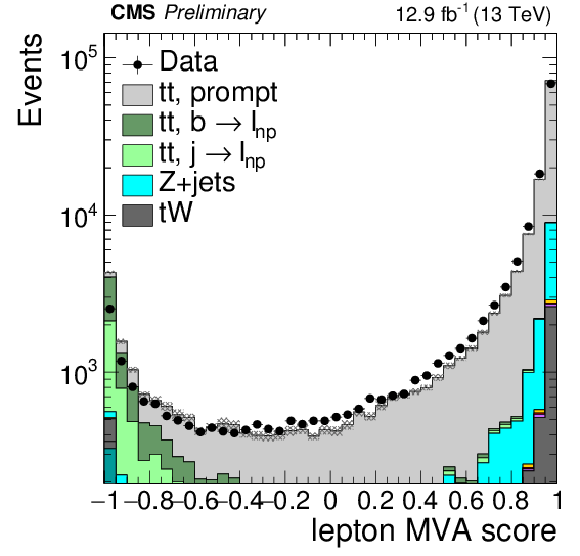
png pdf |
Additional Figure 9-a:
Lepton MVA (BDT) score of the trailing lepton in dileptonic ${\mathrm{ t } {}\mathrm{ \bar{t} } } $ events for opposite sign pairs (a), i.e. enriched in prompt leptons, and for same-sign pairs (b), enriched in non-prompt leptons. The hatched area represents the uncertainty due to the limited sample sizes of simulated events. Leading leptons in the events are required to pass the ``tight'' selection, including an MVA score of greater than 0.75. |
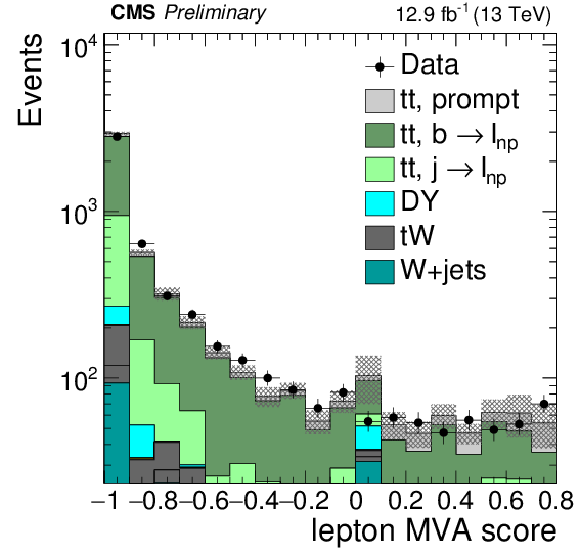
png pdf |
Additional Figure 9-b:
Lepton MVA (BDT) score of the trailing lepton in dileptonic ${\mathrm{ t } {}\mathrm{ \bar{t} } } $ events for opposite sign pairs (a), i.e. enriched in prompt leptons, and for same-sign pairs (b), enriched in non-prompt leptons. The hatched area represents the uncertainty due to the limited sample sizes of simulated events. Leading leptons in the events are required to pass the ``tight'' selection, including an MVA score of greater than 0.75. |
| References | ||||
| 1 | CMS Collaboration | Observation of a new boson at a mass of 125 GeV with the CMS experiment at the LHC | PLB716 (2012) 30--61 | CMS-HIG-12-028 1207.7235 |
| 2 | ATLAS Collaboration | Observation of a new particle in the search for the Standard Model Higgs boson with the ATLAS detector at the LHC | PLB716 (2012) 1--29 | 1207.7214 |
| 3 | ATLAS and CMS Collaborations | Combined Measurement of the Higgs Boson Mass in $ pp $ Collisions at $ \sqrt{s}=7 $ and 8 TeV with the ATLAS and CMS Experiments | PRL 114 (2015) 191803 | 1503.07589 |
| 4 | ATLAS Collaboration | Measurements of the Higgs boson production and decay rates and coupling strengths using pp collision data at $ \sqrt{s}=7 $ and 8 TeV in the ATLAS experiment | EPJC76 (2016), no. 1, 6 | 1507.04548 |
| 5 | CMS Collaboration | Precise determination of the mass of the Higgs boson and tests of compatibility of its couplings with the standard model predictions using proton collisions at 7 and 8 TeV | EPJC75 (2015), no. 5, 212 | CMS-HIG-14-009 1412.8662 |
| 6 | ATLAS and CMS Collaborations | Measurements of the Higgs boson production and decay rates and constraints on its couplings from a combined ATLAS and CMS analysis of the LHC pp collision data at $ \sqrt{s} $ = 7 and 8 TeV | ATLAS-CONF-2015-044, CMS-PAS-HIG-15-002 | |
| 7 | CMS Collaboration | Search for the associated production of the Higgs boson with a top-quark pair | JHEP 09 (2014) 087, , [Erratum: JHEP10,106(2014)] | CMS-HIG-13-029 1408.1682 |
| 8 | ATLAS Collaboration | Search for $ \text{H} \to \gamma\gamma $ produced in association with top quarks and constraints on the Yukawa coupling between the top quark and the Higgs boson using data taken at 7 TeV and 8 TeV with the ATLAS detector | PLB740 (2015) 222--242 | 1409.3122 |
| 9 | ATLAS Collaboration | Search for the Standard Model Higgs boson produced in association with top quarks and decaying into $ b\bar{b} $ in pp collisions at $ \sqrt{s} $ = 8 TeV with the ATLAS detector | EPJC75 (2015), no. 7, 349 | 1503.05066 |
| 10 | ATLAS Collaboration | Search for the associated production of the Higgs boson with a top quark pair in multilepton final states with the ATLAS detector | PLB749 (2015) 519--541 | 1506.05988 |
| 11 | CMS Collaboration | Search for ttH production in multilepton final states at $ \sqrt{s} = $ 13 TeV | CMS-PAS-HIG-15-008 | CMS-PAS-HIG-15-008 |
| 12 | CMS Collaboration | Particle-Flow Event Reconstruction in CMS and Performance for Jets, Taus, and MET | CDS | |
| 13 | CMS Collaboration | Commissioning of the Particle--Flow reconstruction in Minimum--Bias and Jet Events from $ pp $ Collisions at $ 7 $~TeV | CDS | |
| 14 | M. Cacciari, G. P. Salam, and G. Soyez | FastJet User Manual | EPJC72 (2012) 1896 | 1111.6097 |
| 15 | M. Cacciari and G. P. Salam | Dispelling the $ N^{3} $ myth for the $ k_t $ jet-finder | PLB641 (2006) 57--61 | hep-ph/0512210 |
| 16 | CMS Collaboration | Determination of Jet Energy Calibration and Transverse Momentum Resolution in CMS | JINST 6 (2011) P11002 | CMS-JME-10-011 1107.4277 |
| 17 | CMS Collaboration Collaboration | Identification of b-quark jets with the CMS experiment | JINST 8 (2013) P04013 | 1211.4462 |
| 18 | CMS Collaboration | Identification of b quark jets at the CMS Experiment in the LHC Run 2 | CMS-PAS-BTV-15-001 | CMS-PAS-BTV-15-001 |
| 19 | CMS Collaboration | Performance of CMS muon reconstruction in pp collision events at $ \sqrt{s} $ = 7 TeV | JINST 7 (2012) P10002 | CMS-MUO-10-004 1206.4071 |
| 20 | CMS Collaboration | Performance of Electron Reconstruction and Selection with the CMS Detector in Proton-Proton Collisions at $ \sqrt{s} $ = 8 TeV | JINST 10 (2015), no. 06, P06005 | CMS-EGM-13-001 1502.02701 |
| 21 | CMS Collaboration | Reconstruction and identification of $ \tau $ lepton decays to hadrons and $ \nu_\tau $ at CMS | JINST 11 (2016), no. 01, P01019 | CMS-TAU-14-001 1510.07488 |
| 22 | K. Rehermann and B. Tweedie | Efficient Identification of Boosted Semileptonic Top Quarks at the LHC | JHEP 03 (2011) 059 | 1007.2221 |
| 23 | CMS Collaboration | Search for SUSY in same-sign dilepton events at $ \sqrt{s} $=13~TeV | CMS-PAS-SUS-15-008 | CMS-PAS-SUS-15-008 |
| 24 | NNPDF Collaboration | Parton distributions with QED corrections | Nucl. Phys. B877 (2013) 290--320 | 1308.0598 |
| 25 | J. Alwall et al. | The automated computation of tree-level and next-to-leading order differential cross sections, and their matching to parton shower simulations | JHEP 07 (2014) 079 | 1405.0301 |
| 26 | P. Nason | A New method for combining NLO QCD with shower Monte Carlo algorithms | JHEP 0411 (2004) 040 | hep-ph/0409146 |
| 27 | S. Frixione, P. Nason, and C. Oleari | Matching NLO QCD computations with Parton Shower simulations: the POWHEG method | JHEP 0711 (2007) 070 | 0709.2092 |
| 28 | S. Alioli, P. Nason, C. Oleari, and E. Re | A general framework for implementing NLO calculations in shower Monte Carlo programs: the POWHEG BOX | JHEP 1006 (2010) 043 | 1002.2581 |
| 29 | E. Re | Single-top Wt-channel production matched with parton showers using the POWHEG method | EPJC71 (2011) 1547 | 1009.2450 |
| 30 | S. Alioli, P. Nason, C. Oleari, and E. Re | NLO single-top production matched with shower in POWHEG: s- and t-channel contributions | JHEP 0909 (2009) 111 | 0907.4076 |
| 31 | T. Melia, P. Nason, R. Rontsch, and G. Zanderighi | $ \text{W}^{+}\text{W}^{-} $, WZ and ZZ production in the POWHEG BOX | JHEP 1111 (2011) 078 | 1107.5051 |
| 32 | T. Sjöstrand et al. | An Introduction to PYTHIA 8.2 | CPC 191 (2015) 159--177 | 1410.3012 |
| 33 | J. Allison et al. | Geant4 developments and applications | IEEE Trans. Nucl. Sci. 53 (2006) 270 | |
| 34 | LHC Higgs Cross Section Working Group | LHC Higgs Cross Section | twiki | |
| 35 | A. L. Read | Presentation of search results: The CL(s) technique | JPG28 (2002) 2693--2704 | |
| 36 | T. Junk | Confidence level computation for combining searches with small statistics | NIMA434 (1999) 435--443 | hep-ex/9902006 |
| 37 | G. Cowan, K. Cranmer, E. Gross, and O. Vitells | Asymptotic formulae for likelihood-based tests of new physics | EPJC71 (2011) 1554, , [Erratum: Eur. Phys. J.C73,2501(2013)] | 1007.1727 |
| 38 | ATLAS and CMS Collaborations, LHC Higgs Combination Group | Procedure for the LHC Higgs boson search combination in summer 2011 | CMS-NOTE-2011-005 | |

|
Compact Muon Solenoid LHC, CERN |

|

|

|

|

|

|